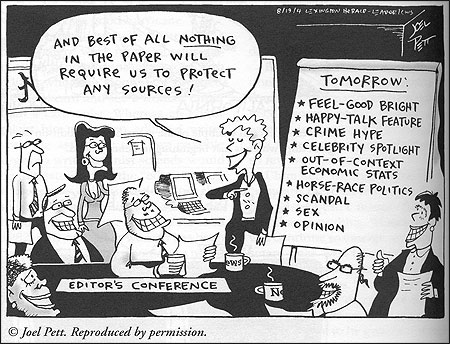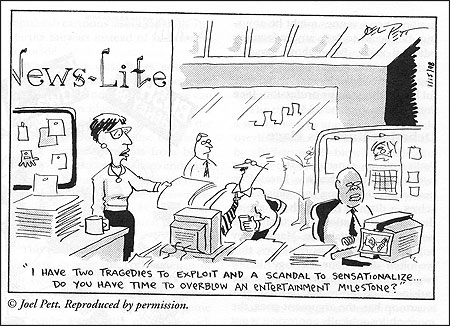
Most people who work in journalism have gotten wind that there is trouble in toontown. Newspaper jobs continue to dwindle. The industry behemoths who have long done without cartoonists, like The Wall Street Journal and The New York Times, are part of a long list, including the St. Louis Post-Dispatch, the Chicago Tribune, and The Dallas Morning News. The Knight Ridder corporate brass in San Jose might well wonder why any of their papers employs a cartoonist, since the hometown Mercury News gets along fine using syndicated stuff. And word of a job loss within the ranks is hardly news in the online chatroom of the Association of American Editorial Cartoonists. No cartoonist I know encourages young people who inquire to pursue this as a career.
So, what’s happening? Here are the usual suspects:
Money. Papers are losing readers and ad revenue is tougher to come by. Why pay someone full time when for a few dollars a week you can buy syndicated cartoons?
Fear. A good editorial cartoon probably annoys, and might even anger, at least half your audience on any day. “Hey, these are our customers—why make them mad?”
Laziness. Good cartooning, like all aspects of journalism, takes work. Finding a cartoonist is work. Working with a cartoonist is work. Arguing with a cartoonist about their approach is work. Taking the phone calls that go along with having a cartoonist is work. Why bother?
Ignorance. Thanks in no small part to the editors at Newsweek, an entire generation of journalists has grown into their careers blissfully unaware that editorial cartoons aren’t just jokes about the news, but visual columns, strong opinion pieces. When relegated to sideshow status, cartoons become basic filler, not the type of stuff you pay someone a full-time salary to produce.
The One-Paper Town. In the old days it was fine to be opinionated and one-sided. But today a lot of editors are uneasy about bludgeoning their readers with the inherently unbalanced work of cartoonists.
The Might of the Right. Although dozens of conservative cartoonists work at papers today, most of the big-circulation names are liberals. (Few good satirists are interested in protecting the status quo.) In today’s political climate, there’s a lot of pressure to be “fair and balanced,” and some of this pressure comes from the publisher’s office.
None of these explanations for our demise stand up to reason. Yes, papers are losing readers, primarily to television, an easy-to-absorb visual media where opinions fly fast and furious. But what mirrors that in a newspaper better than an editorial cartoon? And while it might make short-term sense to let a cartoonist go, in the long run a newspaper cuts its own throat by making the paper less interesting by robbing it of personality. Sacking the cartoonist also deprives a paper of local cartoons, which can get a community talking about your pages. Besides, it’s widely known that the news industry isn’t going broke; newspapers could well afford to hire cartoonists, if it was a priority.
Do we anger readers? Sure we do, and Rush Limbaugh infuriates me, which is why I listen to him. Same with Bill O’Reilly or, for that matter, President Bush. If you want everyone to like you, you’re in the wrong business. The charge of laziness is, I think, true. I’ve seen plenty of word-weary editors and op-ed editors who just can’t be bothered when it comes to thinking about the editorial page cartoon, given the crush of their deadlines. One cartoon is as good as the next, as long as it fits the space and doesn’t cause them to take phone calls.
The disservice done by the dumbing down of the craft is almost immeasurable. Though I named Newsweek, that magazine has plenty of allies including, all too often, the Week in Review editors at The New York Times. My sense is that they substitute their issue-fatigue, which sets in after years of poring over serious and often-grim news reports, for journalistic judgment. When they see something that brightens their day by giving them a chuckle, they publish it. Trouble is, the readers have plenty of entertainment-chuckle options. They turn to the editorial pages specifically for the opposite. But try telling a big-city editor they’ve got it all wrong. Believe me, they’ve earned their reputations for arrogance.
Editors in one-paper markets have a responsibility to be fair. Applied to cartooning, this means publishing a lot from many viewpoints. It’s not hard; it just takes a little effort. Since I’ve been involved with selecting cartoons for the Sunday Los Angeles Times for the past few months, I’ve been truly impressed at the range of imagination, creativity and originality displayed by my peers, even when I don’t agree with them.
As for handling pressure, here’s a novel idea for editors about dealing with conservative critics, politically correct liberals, single-issue interest groups, and even publishers: Stand up to them, and show a little courage of your convictions. Journalism isn’t just another business, it’s critical to the conduct of democracy, remember?
Joel Pett is the Pulitzer Prize-winning editorial cartoonist for the Lexington Herald-Leader. He also draws for USA Today, and his cartoons are distributed by Cartoonists and Writers Syndicate.



